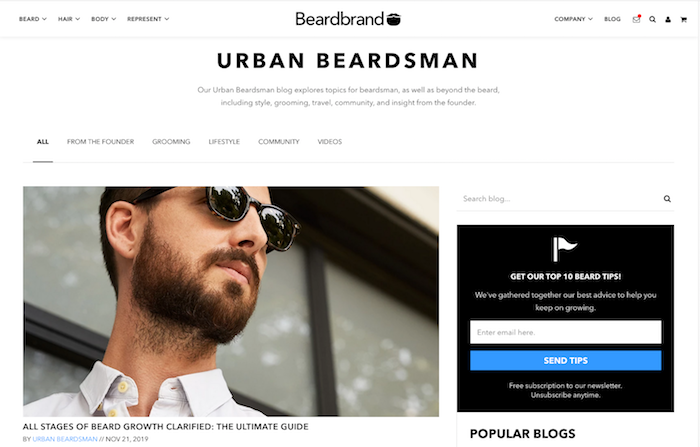Quickstart Guide: Using WordPress Vs. Shopify to Build Your Brand Through Content Marketing

Into the Gloss is the online magazine by DTC darling, Glossier
In recent years, direct-to-consumer (DTC) brands have become a headline story in retail. This is an exciting development, but haven’t direct-to-consumer companies always existed? Indeed, retailers have sold straight to their customers since the start of commerce. Yet this DTC era is something new. That’s because modern DTC brands don’t only sell to their customers, they also connect with them through content. Take Glossier: their products are immensely popular, but so is their branded magazine Into the Gloss. The content is relatable and cool, it strengthens Glossier’s brand identity, and it creates community.
Onsite ecommerce content marketing – blogs, interviews, magazines, tutorial videos, you name it – is now a major component of ecommerce. While most ecommerce platforms offer some content functionality, two platforms have become frontrunners: WordPress and Shopify. We work with a lot of merchants who publish their content on one or the other of these platforms. As a result, over time, we’ve identified the pros (and cons) of content marketing with each one. Here’s our quickstart guide to what we’ve learned.
WordPress Offers A Lot of Customization for Ecommerce Content Marketing

With both WordPress and your ecommerce platform, you’ll likely be able to style the content you create in any way you can imagine. But it goes further with WordPress: you’re not limited to types of content you can store, create, categorize and/or arrange on a page. Simply put, WordPress is open-source, meaning you and your dev team can build it in any way you want. In the case of ecommerce content marketing that means you can customize not only the look of your content, but also the data points you store and the functionality behind them.
With WordPress’ newer editing tools, you and your dev team can create tools that allow you to control layout and presentation while maintaining brand integrity and consistency. Using rich taxonomies, native and custom, you may be able to automate association of content to the shopping experience. Additionally, the WordPress REST API will grant you the capability of accessing all of this well-structured data from within your disparate ecommerce channels.
If your blog has a lot of data, complex data relationships, or a bunch of extra user interaction requirements for articles, then WordPress is definitely the way to go. That’s because WordPress excels in customization and you can modify it extensively.
A good example of content marketing on WordPress comes from S’well, the company known for their reusable bottles. Over the summer, they launched a new line of reusable snacking containers. The company gave the new product line its own navigation tab on their WordPress site, plus they promoted the news on their blog. The post shared about the product materials, features, and cool tips for usage. As a result, not only did they seamlessly fold a new product line into the site, they promoted it through engaging content that’s relevant to their users. It communicates the passion behind their products and brings like-minded shoppers into their community.
But Shopify May Have Everything You Need

The flip side is that if your ecommerce content marketing needs are truly satisfied by a blog, you may get the functionality you need, without having to customize anything, on Shopify. This will also have the added benefit of being less expensive and time-consuming to build because you’re using tools native to the platform. (You can always customize built-in tools to a certain degree as well.)
So, if your blog is not too complicated, you can publish it on Shopify and successfully fulfill most of the common content functionality. With Shopify you can:
- Set a title
- Add any HTML you want to the content of the post
- Craft a custom summary
- Set the SEO information
- Set a featured image
- Designate an author
- Schedule a publish date
- Categorize articles with tags
- Add custom data with metafields
Given that these common features are available on Shopify, it’s also worth noting that you’ll get the added benefit of having your content and your ecommerce site – product info, customer info, etc. – all managed from the same platform. You could also see some SEO benefits as these two sides of your business will be on the same domain.
Beardbrand, a site that sells beard grooming products and more on Shopify, offers a really nice range of articles on their content marketing site, Urban Beardman. They share everything from early articles from the company’s founder to educational videos on how to maintain various types of beards. This depth of content goes a long way in establishing their expertise and bringing their hirsute community together.
Subtle, But Important, Differences Between Shopify and WordPress
As we’ve been in the development work of content marketing on both Shopify and WordPress, we’ve come to see some small, but important, distinctions between the two platforms.
- Shopify doesn’t track changes to blog posts. If you or your marketing team like to look through content revisions and revert to them, know that this feature doesn’t exist in Shopify. On the other hand, WordPress does allow team members to track changes.
- Shopify allows categorizing – but only by tags, not by categories. WordPress, however, allows both hierarchical taxonomies (categories can be nested) and non-hierarchical taxonomies (tags all exist at the same level). And with WordPress, those taxonomies can be easily shared by some or all of your post types, making the automation of related content display much simpler. Typically categories are translated to tags when migrating to Shopify. If you use both categories and tags on your current content pages, you’ll need to get creative if you want to keep these separate. Sometimes we prefix tags to tell them apart (‘tag: tagname’). Or sometimes we build tags or categories into a separate blog, i.e. the ‘news’ and ‘events’ categories each become a new blog. But sometimes we don’t differentiate between tags and categories at all.
- Shopify allows you to have multiple ‘blogs’. For example, one blog for “news” and one for “events.” An article can only be in one blog at a time, but it can be moved from blog to blog. It’s possible to create a blog for “top articles” or use blogs to otherwise categorize your articles. (You can also use one blog for all articles.)
- The url structure inside Shopify is less flexible than in WordPress. For instance, in Shopify, you get ‘/blog-slug/article-slug’ with no options for changing that rule. You can change the slug itself, but you can’t change the order that Shopify presents.

Ecommerce content marketing drives customers to your product site and helps create an engaged, loyal community around your brand. Increasingly, it’s a critical component of your retail business plan. Before you set your long-term plan, however, confirm the best ecommerce content marketing strategy with your development team. (Remember to create a content strategy during the replatforming process, too.) This kind of onsite marketing is sure to become an essential communications tool for your business.
